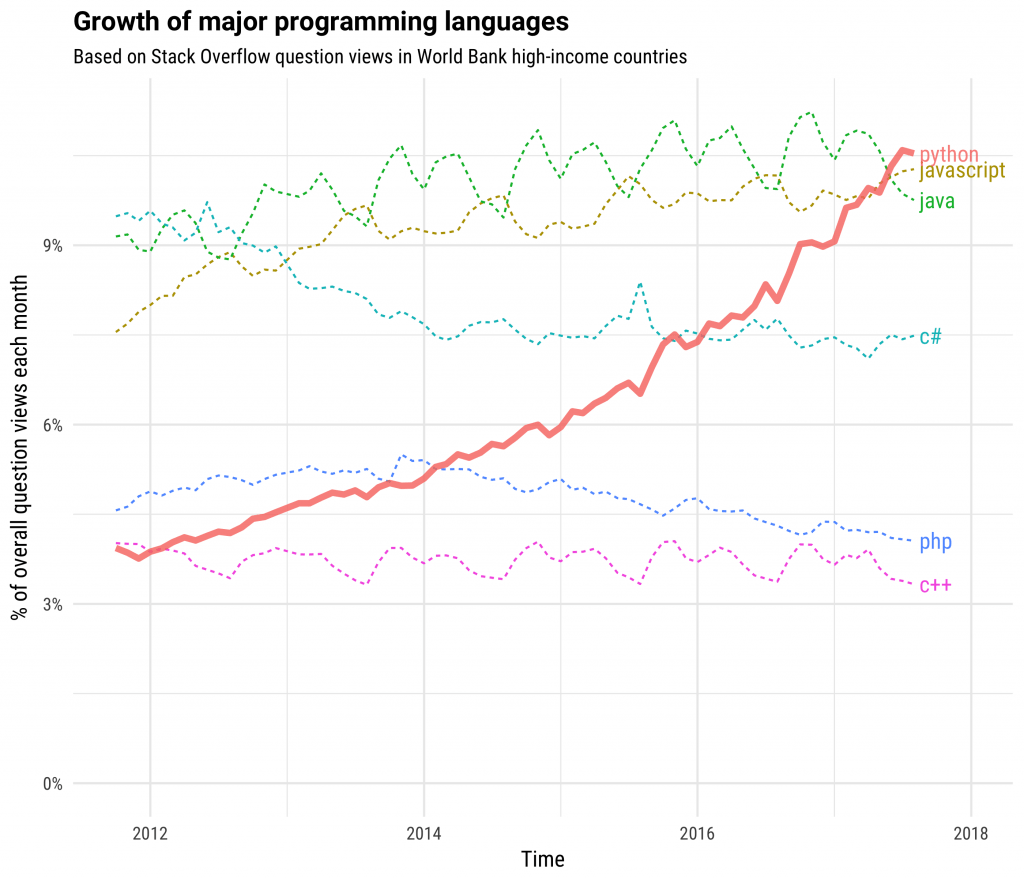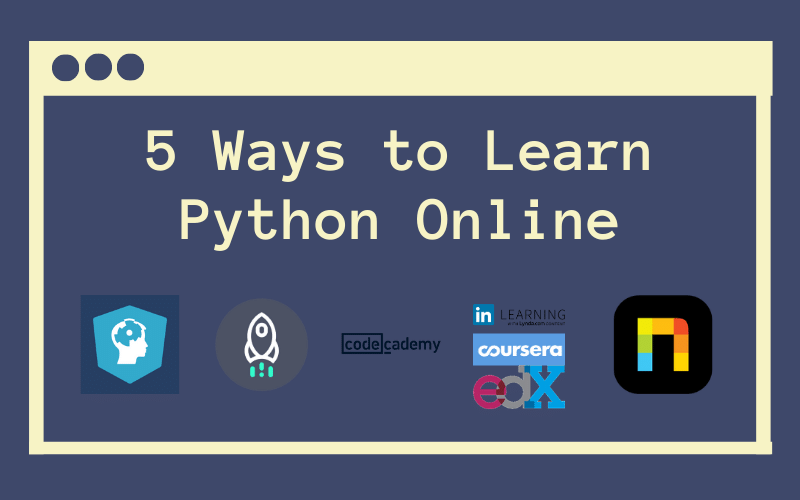Discover the top five ways to learn Python online for your career development. This article provides insight into different platforms and how they support the learning of Python, a programming language currently in high demand.
Key Insights
- Python is a popular programming language, with online resources for learning it increasing in alignment with its growth.
- Platforms such as DataCamp, Dataquest, and Codecademy offer interactive, self-paced ways to learn Python online, particularly for data science.
- Online Learning Platforms like LinkedIn Learning, edX, Coursera, Udemy, and Udacity provide video courses on Python, although they require more setup from the user.
- Live Online Training offers an alternative learning method, with instructor access and community engagement similar to in-person classes.
- Noble Desktop offers industry-leading Python classes live online, catering to different knowledge levels and learning goals.
- Free resources for learning Python online are also available, including interactive tutorials and online courses.
It has never been easier to learn Python online, from the comfort of your home. In this article, we’ll go through various platforms and courses for you to master the skills you need in Python for data science. We'll cover some of the key reasons to learn Python, how to do it online, and the handful of options for Python classes online.
Summary: Top 5 Ways to Learn Python Online
DataCamp: DataCamp provides an easy and interactive platform to learn Python for data science. Free intro class available.
Dataquest: Another good option for self-paced, interactive, and online learning.
Codecademy: A great platform for learning a variety of programming languages online, interactively including Python.
Online Learning Platforms: There are a handful of platforms with video courses including LinkedIn Learning, edX, Coursera, Udemy, Udacity, and more.
Live Online Training: An alternative to self-paced learning, live online training gives you the instructor access, accountability, and community of an in-person class from the comfort of your home.
Keep reading to learn more about learning Python, in-depth review of these options, and more free resources to learn Python.
Why Learn Python
You’ve probably heard by now—Python is booming in popularity. According to the most recent survey by Stack Overflow, Python is the “most wanted” programming language for the second year running. More people wish they could work with Python, in other words, than any other language.

Source: Stack Overflow.blog
Usage numbers show the same kind of growth. Python has recently climbed into the top three on the TIOBE index, which tracks the number of engineers, courses, and vendors associated with each programming language. As for the future, this trend is likely to only strengthen, since Python has recently become the most common introductory programming language at top universities as well.
Rise of Big Data
So what is driving all of this demand for Python? The single most significant factor is the rising importance of data. In recent years, data has become central to all kinds of businesses and professions. Today executives, marketers and UX designers are all expected to be “data-driven” in their work. Companies like Facebook and Google have proven that an advantage in data can be massively profitable, and a plethora of startups based on AI and machine learning are seeking to follow suit. Wall Street itself is increasingly run by machine learning algorithms. And, from all of this demand, a vast array of tools for manipulating data have emerged. However, among all these tools Python is unique. Python alone combines:
Modern software infrastructure
A broad open-source community
Short, readable code
Python Versus
Python has advantages over many of the previously-standard tools like Excel, which we go through in our Python vs. Excel article. In short, Python allows for more scalability, automation, data connectivity, and more, where tools like Excel and Tableau fall short. Writing code brings your analytics to a whole new level and once you experience the power of Python you will not go back to the old tools. Will Python you can work with more data faster and create repeatable and automated workflows and visualizations.
Python Online
With the rise in popularity of Python and data science, there has also been a rise in online resources and courses dedicated to learning Python. It has never been easier to learn Python from the comfort of your home, and in this article, we’ll go through various platforms and courses for you to master the skills you need in Python for data science.
To learn more about Python and data science, its uses, the tools needed to get started, and more see our completely free 1-hour seminar Get Started in Python for Data Science.
Top 5 Ways to Learn Python Online
1. DataCamp
DataCamp is an online, on-demand interactive platform that focuses on Python and R for data science. They have various data science tracks across a handful of tools. One of the best things about experiences like DataCamp is the learn-by-doing, interactivity of the classes. Each lesson has exercises that you can work through within the site UI (without having to download Python). You can get help as you try to tackle the problems with error messages and help forums. DataCamp takes a lot of the initial friction of learning Python out by removing any of the setup and easing you in slowly.
You can start for free with the introductory Python for Data Science class. If you are looking to learn Python for data science with project-based learning, DataCamp is a great option.
Ease of Use: No prior knowledge required, no setup required.
Pricing: $25/mo billed yearly (basic plan)
2. Dataquest
A very similar option to DataCamp, Dataquest also offers a fully in-site, interactive experience to learn programming for data science. They are primarily focused on data analytics in Python and R as well. Training is also interactive and project-based within the site UI. Get started with Python for Data Science: Fundamentals.
Ease of Use: No prior knowledge required, no setup required.
Pricing: $29/mo for monthly; $24.50/mo billed yearly
3. Codecademy
Codecademy is another great option for interactive Python classes online. The key difference here is that classes are more programming-heavy as opposed to data science-focused. If you are looking to learn the essentials of programming using the language of Python, then Codecademy is a great option. They offer classes in lots of other programming languages as well across web development, programming, and data science. They offer a free trial as well as this free Python 2 class.
Ease of Use: No prior knowledge required, no setup required.
Pricing: $19.99/mo
4. Online Learning Aggregators
The online learning platforms generally offer classes across tons of subjects in business, programming, science, and more. Some are pay-per-class while some are subscription-based. Many of them offer certificate programs, quasi-degrees, and other forms of certification. These are generally video-based courses and therefore don’t offer the same interactivity as the above platforms. They also require more setup as you need to download Python and set up your coding environment to get started, which can often be challenging for those new to programming altogether.
EdX: This platform has tons of classes spanning architecture to programming to physics and works on a pay-per-class. They offer a free Introduction to Python course from Microsoft.
LinkedIn Learning: This platform offered by LinkedIn has a ton of courses across business, tech, and creative skills and works on a subscription model for only $29.99/mo billed monthly or $19.99/mo billed annually. This is a great option for those looking to learn across a variety of subjects. Get started with Python for Data Science Essential Training Part 1, one of the most popular data science courses on LinkedIn Learning.
Other Aggregators include Coursera (Python Courses), Udemy (Python Courses), and Udacity (Free Introduction to Python Programming)
5. Live Online Training
While the on-demand, online options above are all great ways to learn Python, there is another alternative for you to consider: live online training. On-demand training can be great if you prefer self-paced learning, but for many people, self-paced learning leaves with lots of started courses and not many completed courses.
Live online training combines the comfort, convenience, and safety (during a virus) of learning online with some of the key perks of in-person training. Live online training means that there is an instructor with you in real-time, online similar to in-person training.
Accountability
There are also other students in the virtual classroom. These elements increase accountability and lead to better outcomes in terms of course completion. You are much less likely to walk out of a live class with an instructor and other students present than you are in an on-demand class with a recorded teacher by yourself.
Instructor Help
Another perk of live online training is the ability to get personalized attention and help from an instructor. Although some of the options above offer support, there is no replacement for having an instructor immediately be able to work you through a problem to get you back on track.
Community & Engagement
The last key element of live online training is a sense of liveliness and community that you are lacking with recorded training. You can communicate with your peers in the class and hear their questions as well. Live online training feels more like a regular classroom, just online, which can keep things a little more engaging and exciting.
Here at Noble Desktop, we offer our industry-leading Python classes live online. Master Python for data science in our Python for Data Science Bootcamp ($1595) or get started in Python with our Python in a Day class ($325) or see all our Python classes.
Other Free Resources
Learn Python—Free Interactive Python Tutorial
10 Free Courses from Hackernoon
Noble Python Blog—Free articles, resources, and tutorials to learn Python





